Mysterious Ancient Ruins Of Engaruka – Why Was The Site Abandoned?
Ellen Lloyd - AncientPages.com - Located in the Great Rift Valley of northern Tanzania, today there are nothing but ruins left of what was once an Iron Age farming community.
Researchers have tried to unravel the mystery of why people living in Engaruka abandoned the site centuries ago. The ancient ruins of Engaruka remind us of how vulnerable our world is to climate changes.
What once may have been one of the biggest inland centers in eastern Africa is now a quiet corner of Tanzania.
Engaurka is considered one of the most important archaeological sites in the Great Lakes region. Today it is a dry, dusty, and sterile place, but it was once a vast irrigated landscape.
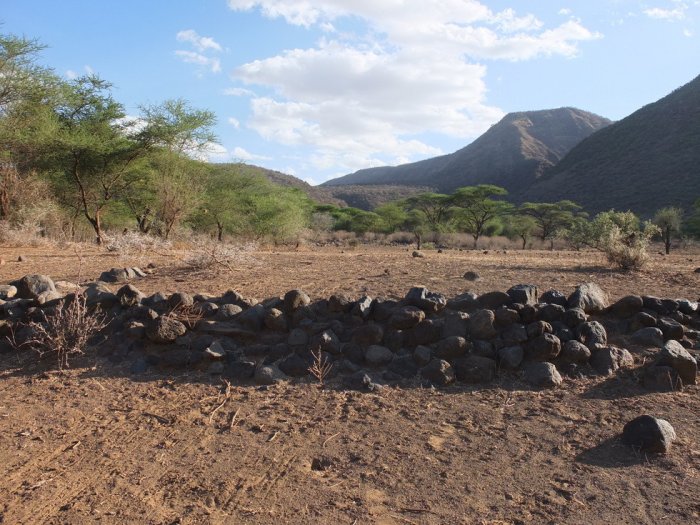
An abandoned terrace. Image credit: Pardee Wamsley - Atlas Obscura
The site has long been a mystery to archaeologists. Who were the inhabitants of Engaruka? How did they develop such a sophisticated farming system and why did they suddenly abandon the site?
The mysterious ruins of Engaruka were discovered in 1883 by Dr. Gustav Fischer, a German explorer of Africa. Dr.Fischer said they resembled tumbled-down walls of ancient castles. Later, in 1896, Drs Scoeller and Kaiser mentioned the ruins of "Ngaruku" including great stone circles and dams. It was not until 1913 that an archaeological survey took place in the region, but the lack of burial sites made it very difficult to determine who created Engaruka.
Modern archaeologists assume that Engaruka was built by ancestors of the Iraqw, a Cushitic-speaking ethnic group inhabiting the Great Lakes region of East Africa. They live in the Arusha and Manyara regions of north-central Tanzania, near the Rift Valley wall and south of Ngorongoro Crater.
The modern Iraqw practice an intensive form of self-contained agriculture that bears a remarkable similarity to the ruins of stone-walled canals, dams and furrows that are found at Engaruka.
See also:
10 Great Ancient Mysteries Of Africa
Researchers from the University of York have been working in East Africa for many years gathering palaeoecological and archaeological evidence on how people interacted with this environment. They think Engaruka was abandoned because of climate change.
"Previous researchers have tended to assume that the people of Engaruka failed to make the land work for them, but the archaeological and environmental data demonstrate that this was a complex farming system that was sustained for well over 300 years,” Dr Daryl Stump from the University of York said.
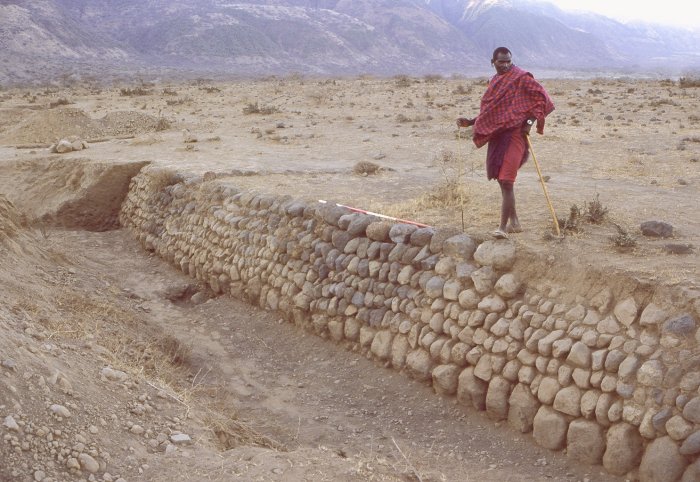
Excavated stone-lined water channel, Engaruka. Image credit: Daryl Stump
Scientists have been able to confirm that Engaruka once had irrigation systems supporting 20 square kilometers of farmland and more than half the fields built by capturing soils carried off the mountainside by water flowing within the rivers and streams.
In a documentary called Grains of Truth, researchers bring together some of the images and footage that the team has gathered over the years and explains how evidence for landscape change in the past can help us to predict and cope with the future of climate change.
In this documentary researchers at the University of York’s Departments of Archaeology and Environment reveal their investigations in Engaruka, a semi-arid savannah region in Tanzania, East Africa.
The unpredictable environment means that people cannot depend entirely on their livestock to sustain them, so they use water management to grow crops on a limited scale. Archaeological evidence, however, is showing that what now appears to be mostly dry, dusty and sterile, was once a vast irrigated landscape. But by the early 1800s, European explorers discovered no evidence of people in the region. Where did they go? Why did the environment no longer support them?
The ruins of Engaruka talk volumes about the highly specialized agricultural economy, but they also show the effects of climate change and pressures on environmental resources.
From an archaeological perspective, Tanzania still remains a rather unexplored region of the world. The Olduvai Gorge is a steep-sided ravine in the Great Rift Valley that stretches through East Africa. It is located in the eastern Serengeti Plains in northern Tanzania.
The gorge is a very important prehistoric site for the study of human evolution. Millions of years ago, volcanic eruptions set down the rocks and layered ash that would become Olduvai Gorge. Volcanic ash and lava layers are dated to the last 2.1 million years of geological and evolutionary history.
The oldest hominid fossils have been recovered from several sites in East Africa and Olduvai Gorge is one of these sites.
Written by Ellen Lloyd – AncientPages.com
Copyright © AncientPages.com & Ellen Lloyd All rights reserved. This material may not be published, broadcast, rewritten or redistributed in whole or part without the express written permission of AncientPages.com and Ellen Lloyd
About the author:
Ellen Lloyd – is the owner of AncientPages.com and an author who has spent decades researching ancient mysteries, myths, legends and sacred texts, but she is also very interested in astronomy, astrobiology and science in general.
Expand for references
More From Ancient Pages
-
 Rare Minoan Sealstone Is A Miniature Masterpiece Unearthed In 3,500-Year-Old Tomb Of Powerful Mycenaean Warrior
Archaeology | Nov 8, 2017
Rare Minoan Sealstone Is A Miniature Masterpiece Unearthed In 3,500-Year-Old Tomb Of Powerful Mycenaean Warrior
Archaeology | Nov 8, 2017 -
 Solar Eclipses And New Attempt To Date Homer’s Iliad And Odyssey
Myths & Legends | Jan 7, 2016
Solar Eclipses And New Attempt To Date Homer’s Iliad And Odyssey
Myths & Legends | Jan 7, 2016 -
 Was Biblical King David Unknowingly Part Of A Secret Master Plan?
Ancient Mysteries | Jul 1, 2021
Was Biblical King David Unknowingly Part Of A Secret Master Plan?
Ancient Mysteries | Jul 1, 2021 -
 Gotu Kola – Extraordinary Ancient Herb That Increases Longevity And Improves Cognitive Abilities
Ancient Traditions And Customs | Mar 13, 2019
Gotu Kola – Extraordinary Ancient Herb That Increases Longevity And Improves Cognitive Abilities
Ancient Traditions And Customs | Mar 13, 2019 -
 Shrine Discovered In Egyptian Temple And Evidence Of Previously Unknown Rituals
Archaeology | Oct 6, 2022
Shrine Discovered In Egyptian Temple And Evidence Of Previously Unknown Rituals
Archaeology | Oct 6, 2022 -
 Harput Relief: 4,000-Year-Old Artifact Pushes Back History Of Region By 1,000 Years
Archaeology | Mar 23, 2017
Harput Relief: 4,000-Year-Old Artifact Pushes Back History Of Region By 1,000 Years
Archaeology | Mar 23, 2017 -
 Native American Population Does Not Originate In Japan – Genetics And Skeletal Biology Questioned
Archaeology | Nov 15, 2021
Native American Population Does Not Originate In Japan – Genetics And Skeletal Biology Questioned
Archaeology | Nov 15, 2021 -
 Mysterious Sherbrooke Stones – Did Africans Visit North America 2,500 Years Ago?
Artifacts | Nov 23, 2017
Mysterious Sherbrooke Stones – Did Africans Visit North America 2,500 Years Ago?
Artifacts | Nov 23, 2017 -
 Ancient Mystery Of The Before – Time People – Evidence Of Unknown Advanced Prehistoric Technology – Part 2
Ancient Mysteries | Apr 5, 2019
Ancient Mystery Of The Before – Time People – Evidence Of Unknown Advanced Prehistoric Technology – Part 2
Ancient Mysteries | Apr 5, 2019 -
 Did The Unique Gjermundbu Viking Helmet Belong To A Warrior Who Served Rulers In The East?
Archaeology | Feb 8, 2022
Did The Unique Gjermundbu Viking Helmet Belong To A Warrior Who Served Rulers In The East?
Archaeology | Feb 8, 2022 -
 Chocolate Was A ‘Hot Property’ In 17th Century England And There Were Rules For Safe Consumption
Featured Stories | Jun 27, 2018
Chocolate Was A ‘Hot Property’ In 17th Century England And There Were Rules For Safe Consumption
Featured Stories | Jun 27, 2018 -
 Scientists Found A Link Between Ancient Human Teeth And An Extinct Reptile
Archaeology | Jan 10, 2022
Scientists Found A Link Between Ancient Human Teeth And An Extinct Reptile
Archaeology | Jan 10, 2022 -
 North America’s Oldest Known Pterosaur – Discovered
Paleontology | Jul 10, 2025
North America’s Oldest Known Pterosaur – Discovered
Paleontology | Jul 10, 2025 -
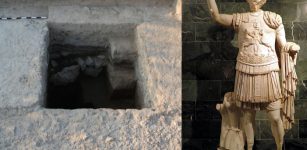 Unfinished Roman Aqueduct Discovered In The Hellenistic Royal City Of Artashat-Artaxata In Ancient Armenia
Archaeology | Nov 16, 2021
Unfinished Roman Aqueduct Discovered In The Hellenistic Royal City Of Artashat-Artaxata In Ancient Armenia
Archaeology | Nov 16, 2021 -
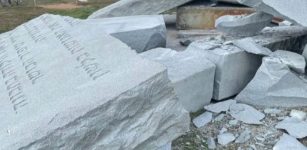 Georgia Guidestones Damaged By An Explosive Device – By Whom And Why?
News | Jul 7, 2022
Georgia Guidestones Damaged By An Explosive Device – By Whom And Why?
News | Jul 7, 2022 -
 Preserve Elfdalian: Sweden’s Secret Forest Language From The Viking Era
Civilizations | May 21, 2015
Preserve Elfdalian: Sweden’s Secret Forest Language From The Viking Era
Civilizations | May 21, 2015 -
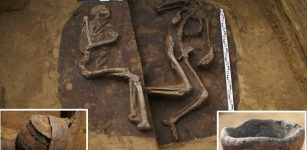 Unusual Grave Of The Trzciniec Culture Is An Archaeological Puzzle
Archaeology | Dec 23, 2019
Unusual Grave Of The Trzciniec Culture Is An Archaeological Puzzle
Archaeology | Dec 23, 2019 -
 How King Arthur Became One Of The Most Pervasive Legends Of All Time
Featured Stories | Feb 12, 2017
How King Arthur Became One Of The Most Pervasive Legends Of All Time
Featured Stories | Feb 12, 2017 -
 Ireland’s Population Was In Decline When Vikings Arrived To Settle
Archaeology | Aug 22, 2019
Ireland’s Population Was In Decline When Vikings Arrived To Settle
Archaeology | Aug 22, 2019 -
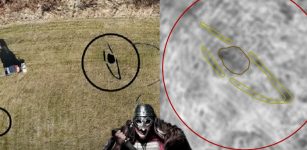 New Huge Viking Ship Discovered By Radar In Øye, Norway – What Is Hidden Beneath The Ground?
Archaeology | Apr 9, 2022
New Huge Viking Ship Discovered By Radar In Øye, Norway – What Is Hidden Beneath The Ground?
Archaeology | Apr 9, 2022

